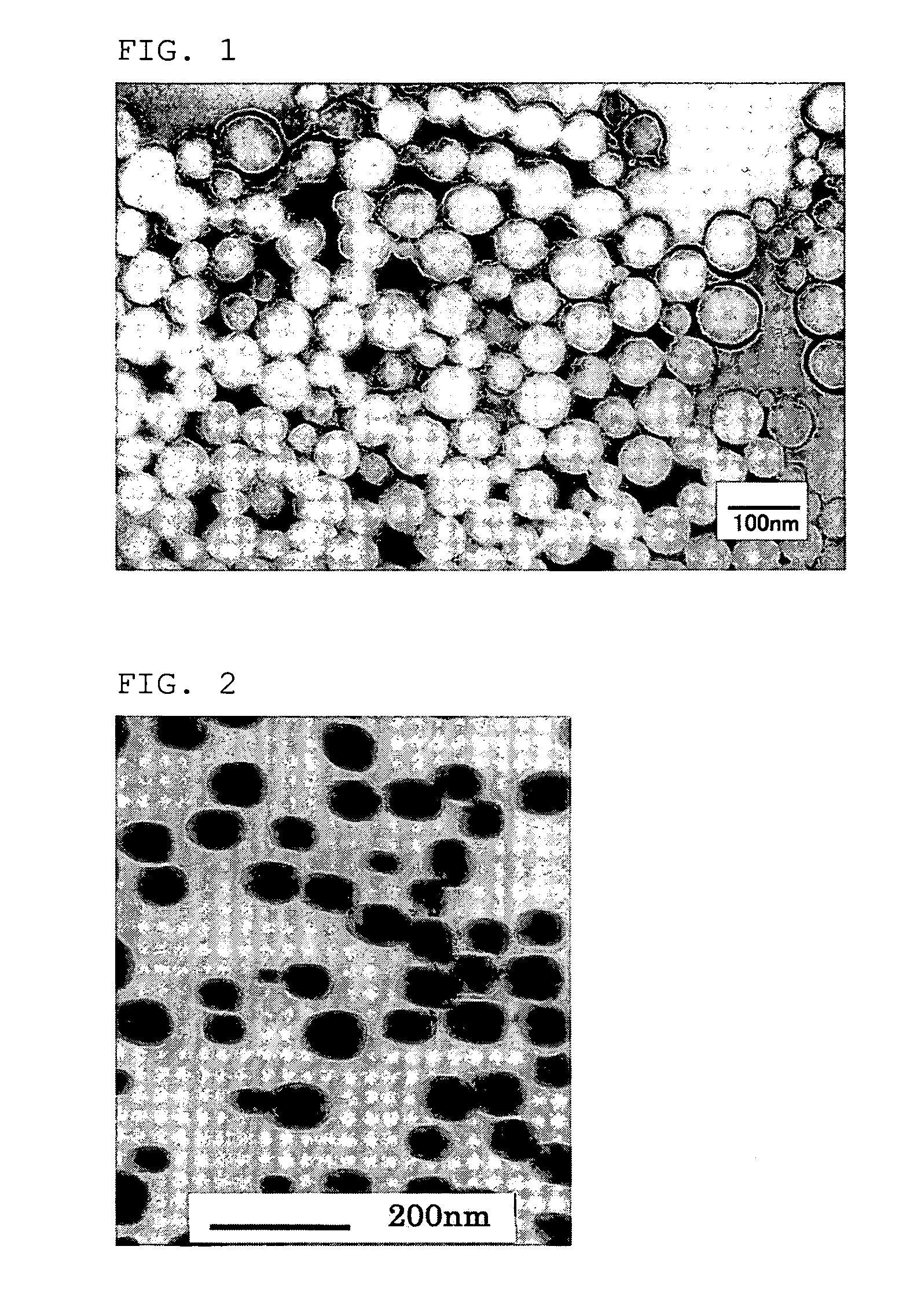Nanofiber aggregate, polymer alloy fiber, hybrid fiber, fibrous structures, and processes for production of them
a technology of nanofibers and aggregates, which is applied in the field of nanofiber aggregates, can solve the problems of insufficient fineness of ultrafine fibers manufactured by this technology to meet the needs of nanofibers, and cannot fully meet the needs of nanofibers, and achieves the effect of less spread of single fiber fineness values
- Summary
- Abstract
- Description
- Claims
- Application Information
AI Technical Summary
Benefits of technology
Problems solved by technology
Method used
Image
Examples
example 1
[0321] A N6 (20% by weight) and a copolymerized PET (80% by weight) were melted and kneaded in a twin-screw extrusion-kneader at 260° C. to obtain polymer alloy chips having a b* value of 4. The N6 had a melt viscosity of 53 Pa.s (262° C. at a shear rate of 121.6 sec−1), a melting point of 220° C., and an amount of terminal amino groups of 5.0×10−5 molar equivalent per gram as a result of blocking amine terminals with acetic acid. The copolymerized PET had a melt viscosity of 310 Pa.s (262° C. at a shear rate of 121.6 sec−1) and a melting point of 225° C., had been copolymerized with 8% by mole of isophthalic acid and 4% by mole of bisphenol A. The copolymerized PET had a melt viscosity of 180 Pa.s at 262° C. and a shear rate of 1216 sec−1. The kneading conditions were as follows.
[0322] Screw type: one-direction fully interlocking double shred
[0323] Screw: diameter of 37 mm, effective length of 1670 mm, [0324] L / D=45.1
[0325] The length of the kneading section was 28% of the effec...
example 2
[0336] Polymer alloy chips having a b* value of 4 were obtained using a twin-screw extrusion-kneader similarly to Example 1, except for using a N6 (20% by weight) having a melt viscosity of 212 Pa.s (262° C. at a shear rate of 121.6 sec−1) and an amount of terminal amino groups of 5.0×10−5 molar equivalent per gram as a result of blocking amine terminals of a melting point of 220° C. with acetic acid. The polymer chips were subjected to the melt spinning process similarly to Example 1, except for setting the discharge rate per orifice to 1.0 gram per minute and shear stress between the spinneret orifice and the polymer at 0.071 MPa (viscosity of the polymer alloy was 170 Pa s at 262° C. and at a shear rate of 416 sec−1). In this procedure, the fiber showed good spinnability and was broken only once during the spinning of 1t. The undrawn yarn of the polymer alloy was drawn similarly to Example 1, except for setting the drawing ratio to 3.0, thereby to obtain polymer alloy fibers havi...
example 3
[0340] Melt spinning was carried out similarly to Example 2, except for using a N6 (20% by weight) having a melt viscosity of 500 Pa.s (262° C. at a shear rate of 121.6 sec−1) and a melting point of 220° C. Then melt spinning was carried out similarly to Example 1, except for setting the shear stress between the spinneret orifice and the polymer at 0.083 MPa (viscosity of the polymer alloy was 200 Pa.s at 262° C. and at a shear rate of 416 sec−1), thereby to obtain an undrawn yarn of polymer alloy. In this procedure, the fiber showed good spinnability and was broken only once during the spinning of 1t. The undrawn yarn was drawn and subjected to annealing similarly to Example 2, thereby to obtain polymer alloy fibers having good properties of 128 dtex, 36-filament, 4.5 cN / dtex in strength, 37% in elongation, U %=1.9% and 12% in boiling water shrinkage. Observation of a cross section of the polymer alloy fiber under a TEM showed islands-in-sea structure where the copolymerized PET fo...
PUM
| Property | Measurement | Unit |
|---|---|---|
| width | aaaaa | aaaaa |
| elongation | aaaaa | aaaaa |
| diameter | aaaaa | aaaaa |
Abstract
Description
Claims
Application Information
 Login to View More
Login to View More - R&D
- Intellectual Property
- Life Sciences
- Materials
- Tech Scout
- Unparalleled Data Quality
- Higher Quality Content
- 60% Fewer Hallucinations
Browse by: Latest US Patents, China's latest patents, Technical Efficacy Thesaurus, Application Domain, Technology Topic, Popular Technical Reports.
© 2025 PatSnap. All rights reserved.Legal|Privacy policy|Modern Slavery Act Transparency Statement|Sitemap|About US| Contact US: help@patsnap.com



